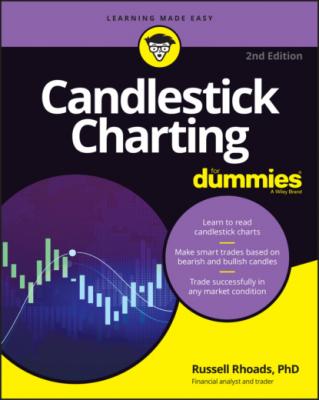ТОП просматриваемых книг сайта:
Candlestick Charting For Dummies. Russell Rhoads
Читать онлайн.Название Candlestick Charting For Dummies
Год выпуска 0
isbn 9781119869979
Автор произведения Russell Rhoads
Жанр Ценные бумаги, инвестиции
Издательство John Wiley & Sons Limited
Making Technical Analysis Part of Your Candlestick Charting Strategy
A stunning amount of mathematical ingenuity is applied to security-trading analysis. The options for technical analysis can be as simple as the average of a few days of closing prices and as complex as applying calculus to price action to indicate the momentum of prices. The possibilities are endless, and you shouldn’t be shy about including some of them in your trading strategy alongside candlestick charts.
I explore several types of technical indicators in Chapter 11 and clue you in on a few ways that you can combine these indicators with candlestick patterns in Part 4 (Chapters 11 through 15). Find a few technical indicators that match up to the type of trading you want to pursue, and add them to your candlestick charts. Read up on the choices, and if Chapter 11 isn’t enough, you can always turn to Technical Analysis For Dummies, 4th Edition, by Barbara Rockefeller (John Wiley & Sons, Inc.). Added understanding of technical indicators can really aid you in your candlestick charting efforts.
Trading Wisely: What You Must Understand Before Working the Markets
Security trading and investing can be a financially rewarding and fulfilling experience, but it’s far from a risk- and stress-free undertaking. I want to make clear to you a few key points and concerns before I dive into my candlestick charting discussion, so that you’re fully aware of what you’re up against and what you can do to maximize rewards and minimize risks.
Trading can be an expensive endeavor
There’s money to be made on the security markets, but don’t be fooled into thinking that earning profits is easy or effortless. Many smart people have taken on trading as a hobby or profession and been quickly humbled by poor trades and losses. Do your homework, and practice wise money management; otherwise, you could end up joining their ranks!
Paper trading costs you nothing but time
Paper trading refers to the practice of tracking trades on paper that haven’t been traded in an account. Professional traders tell you that paper trading isn’t the same as putting real money at risk on the markets. As a professional trader, I totally agree. The emotional roller coaster involved with making and losing money can’t be matched in a dry run. But if you’re a novice who’s just starting to understand the ways of the market, I think that paper trading is a great idea. The risks are nil, and the educational benefits are outstanding. Even with more than 25 years of trading experience, I still tend to paper-trade new ideas or systems for a while before putting real money to work.
For those who try paper trading but lose interest because they have no skin in the game, I suggest making a very small trade in a live account. The size of your trade and the risk you’re taking to try out a new strategy should be inconsequential relative to your net worth.
Develop rules, and stick to them
Throughout this book, I stress the importance of setting rules for yourself and sticking to those rules. I just can’t stress enough what a good practice that is for any trader. Making and losing money on the market is a very emotional experience. One of the main reasons why some traders lose big when they should lose (or even win) just a little is that they let their emotions take control of their trading. You can take emotions out of the equation if you develop trading rules and adhere to them no matter what happens.
Create a set of trading rules for yourself, and stick to them. Include rules such as the following:
When to get into trades
Where to place stops in various trading situations
What amount of money to risk on trades and investments
When to get out of trades, either with a loss or profit
I’ve been trading for a long time, and I can say without reservation that creating and adhering to a set of trading rules is the best way to reward yourself, both personally and financially, for the effort you put into the markets. I always follow the rules that I’ve set for myself, and although it may sound crazy, at this point I’m prouder of my rules than I am of my profits. All traders have to come up with their own sets of rules that talk to their trading style and comfort with risk, and you should keep that fact in mind and jot down potential rules as you explore the contents of this book.
Chapter 2
Getting to Know Candlestick Charts
IN THIS CHAPTER

